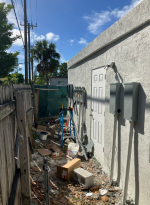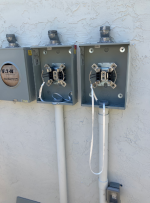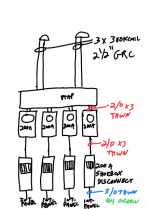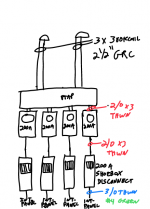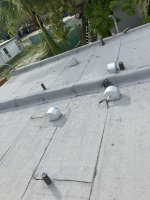2Broke2Sleep
Senior Member
- Location
- Florida
Hi, this is my first new service build as an EC. I've got a 4 unit residential complex with 200A panels inside each residence. On the outer wall I have what is depicted, 4 meters piped into 4 x 200A Disconnects, which are piped into interior panelboards. I have the meters, disconnects, and panelboards in place, but I have not yet sized the overhead or the trough that is going above the meter enclosures. I am weighing costs of: one mast with large conductors vs. two masts with parallel conductors . The plans are inaccurate/missing the service and the owner/builder won't get them revised, he just wants me to install to code and he said he will get them revised based on what I do if needed.
I don't have it in front of me but I did a load calc using mike holts spreadsheet and a single mast would call for 600kcmil conductors. I plan on using Polaris Taps to branch off each service with 2/0 to the line side of each meter from within the trough. It would be nicer to have some kind of busbar I could mount inside the trough to land the conductors on but I am looking for the most cost effective install right now.
Looking at NEC 2017 / 366.22 (A): Sheet Metal Auxiliary Gutters. The sum of the cross sectional areas of all contained conductors and cables at any cross section of a sheet metal auxiliary gutter shall not exceed 20 percent of the interior cross-sectional area of the sheet metal auxiliary gutter..................
So working that out with (12) 2/0 thhn conductors and (3) 600 kcmil conductors would be:
Ch. 9 Table 5 :
THWN/THHN 600kcmil Approximate Area 0.8676 in^2 x 3 = 2.6028 in ^2
THWN/THHN 2/0 Approximate Area 0.2223 in^2 x 12 = 2.6676 in ^2
Sum of above: 5.2704 in ^2
** 5.2704 / 20% = 26.352 in ^2
So technically I could use a tiny 26 square in. trough legally if I could actually fit all the conductors inside one.

I don't have it in front of me but I did a load calc using mike holts spreadsheet and a single mast would call for 600kcmil conductors. I plan on using Polaris Taps to branch off each service with 2/0 to the line side of each meter from within the trough. It would be nicer to have some kind of busbar I could mount inside the trough to land the conductors on but I am looking for the most cost effective install right now.
Looking at NEC 2017 / 366.22 (A): Sheet Metal Auxiliary Gutters. The sum of the cross sectional areas of all contained conductors and cables at any cross section of a sheet metal auxiliary gutter shall not exceed 20 percent of the interior cross-sectional area of the sheet metal auxiliary gutter..................
So working that out with (12) 2/0 thhn conductors and (3) 600 kcmil conductors would be:
Ch. 9 Table 5 :
THWN/THHN 600kcmil Approximate Area 0.8676 in^2 x 3 = 2.6028 in ^2
THWN/THHN 2/0 Approximate Area 0.2223 in^2 x 12 = 2.6676 in ^2
Sum of above: 5.2704 in ^2
** 5.2704 / 20% = 26.352 in ^2
So technically I could use a tiny 26 square in. trough legally if I could actually fit all the conductors inside one.


